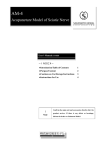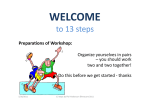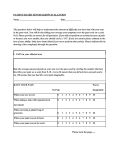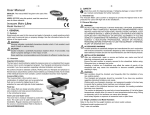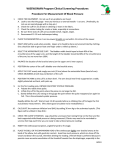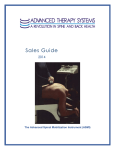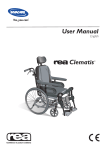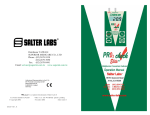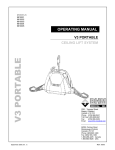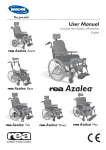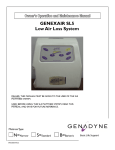Download 13 STEPS TO A BASIC SEATING POSTURE Passive
Transcript
13 STEPS TO A BASIC SEATING POSTURE Passive Wheelchairs Introduction This checklist has been devised as a tool to aid the basic assessment of a client in a passive or comfort wheelchair. There are multitude of accessories available for this process and we have chosen to focus on a small selection. For more information about accessories, please refer to the Invacare Rea sales literature or go to www.invacare-rea.com or www. invacare.co.uk Thanks for contributing to safer seating posture! Goal •To evaluate the posture of the client •To have a logical sequence in adjusting a seating system for your client •To check how the client is seated after you have made a change in the existing seating system •To be able to measure differences before and after a fitting/ assessment The first column of the checklist explains the 13 steps. It contains the main questions and hints on how to check the critical areas. The next column tells you what to adjust (refer to the user manual for product specific information) and what to aim for. The final column identifies possible problem areas and considerations: if something does not work during one of the steps, the problem area will give solution suggestions. The checklist takes assumes that you are aware of the way the pelvis and spine interface with each other and with the rest of the body. Points to remember •The client must sit in a wheelchair. •Examination - explain what you want to check and that you will need to touch them - with their permission. •The wheelchair sizes should correspond to the size of the client. •As the different body parts are interconnected a change in one position may have consequences on previous adjustments. •Make one adjustment at a time. Analyze the results before each adjustment. © Invacare International Sàrl 2009 13 STEPS TO A BASIC SEATING POSTURE Passive Wheelchairs Checklist What to adjust and the aim Possible problem areas / Considerations 1. 1 Mapping the user Remember that the client relatives, therapist, etc. may have different opinions about goals A. Activities in daily living B. Physiological condition C. Psychological factors D. Social situation E. Economical factors 1.2 Preparations 1. Tilt and recline the chair slightly 2. Remove the legrests 3. Put a cushion or support under the feet Relaxed feet position Check pressure distribution of the buttocks with your hand comparing backrest with seating 2. Position of buttocks in the chair Is the client sitting as far into the seat as possible? Should the backrest be slightly reclined? Lean the client forward and check the position from above by palpating the buttocks. Seat depth The client should sit as far back as possible The upper inside of the calf should not touch the seat cushion. Strive for a 2-3 cm space To be done before and after the adjustment 3. Pelvic symmetry Palpate SIAS/ ASIS Check whether the two upper pelvic edges are level. After adjustment, check pressure with two fingers, between side guard and Trochanter © Invacare International Sàrl 2009 The hamstrings should be relaxed. This is achieved naturally if the user can move their feet to a preferred position Seat width Should be as narrow as possible without allowing direct pressure Kneel in front of the client so you are at eye level with your hands when palpating SIAS/ ASIS The armrest sides should “just” touch the buttock sides at Trochanter area 13 STEPS TO A BASIC SEATING POSTURE Passive Wheelchairs Checklist What to adjust and the aim 4. Position of the feet 1. Check hamstring tightness 2. Choose and add legrests that correspond to the preferred position that the client has selected 3. Check if the feet are bearing weight 4. Check height of foot plate 5. Check pelvic position by SIAS 5. Position of thighs Check if the thighs are parallel and straight and facing forward Check that the hamstrings are relaxed 6. Seat angle and cushion 1. Assess how the body pressure should be divided between seat and backrest 2. Create a stable sitting position 3. Insert your hand between client and seat, little finger first, and feel the pressure both before and after the adjustment 4. Check patient for comfort 5. Check risks of decubitus (pressure ulcer) – use the Norton scale or similar and proceed accordingly © Invacare International Sàrl 2009 Footrest height, angle and depth Legrests angle Calf pad support – adjust height and depth The feet should be positioned so the pelvis is in a natural position Adjust the width of the legrests to avoid pressure on knees The legs should be as straight as possible Adjust the seat angle (tilt) with the lever at the rear of the backrest There should a large contact area between seat and backrest Possible problem areas / Considerations Hamstrings should never be tight – it will pull the pelvis into a backward rotation! Check hamstring tendons for relaxed position Pressure applied under the soles of the feet stimulate upright posture and help to keep them on the footplates Use two fingers for pressure checks at cushion level – both top and front The upper legs should not be abducted, adducted or wind-swept Make sure that you have a seat cushion that allows enough space for the ischial tuberocities The seat should be tilted just enough to maintain balance and feel secure. Check that eyes and ears are level: this ensures that the client remains alert 13 STEPS TO A BASIC SEATING POSTURE Passive Wheelchairs Checklist 7. Back angle 1. Check position of head and how it is balanced in the spine 2. Lean the client forward and check the position from above by palpating the both buttocks What to adjust and the aim Adjust the backrest angle with the lever at the rear to a relaxed position Check for comfort Ears and eyes should be parallel with the floor and the complete backrest should support the backrest of the client 8. Back height Adjust the backrest height Check for comfort and mobility Check with your hand for pressure distribution 9. Back shape Check support of preferred posture. Use your hand for pressure evaluation 10. Arm rest Evaluate the support both for upper and lower trunk by giving stabilisation with your hands © Invacare International Sàrl 2009 The support should be at least up to the client’s arm pits If not sufficient adjust with wedges and/ or the tension-adjustable backrest Strive for mobility movement without locking the posture Possible problem areas / Considerations To avoid sliding out of the chair, have the backrest as upright as possible Make sure that the shoulder blades are not pushed forward Strive for a natural pelvic position. Ensure that firm support is given just at the upper pelvis (sacrum-iliac joint) to avoid backward rotation of pelvis Adjust height and depth Shoulder area should be relaxed Does it give support during transferal/ body shifting 13 STEPS TO A BASIC SEATING POSTURE Passive Wheelchairs Checklist 11. Lateral / trunk support What to adjust and the aim Adjust the depth and height Create upper body stability The body posture should be stable thanks to rear rather than side support 12. Head support Adjust height and angle and loosen all screws then adjust from the bottom to the top Check the reason: 1. Support during transportation 2. Tilt in space Possible problem areas / Considerations Could another backrest cushion/ backrest base give better support? Support area for car- transportation Neck and headrests should be used when seat angle is > 105º Support area for normal use 13. Tilt in space Check interval of relevant use Adjust the backrest angle with the lever at the rear Make a final check with your hand around the user for distribution of pressure - this will indicate if optimum support is being given Tilt should be used in short periods for weight and pressure distribution purposes © Invacare International Sàrl 2009 As tilt increases, the pressure distribution transfers from the seat to the backrest area Please note that a greater tilt angle increases drowsiness and decreases activity levels





